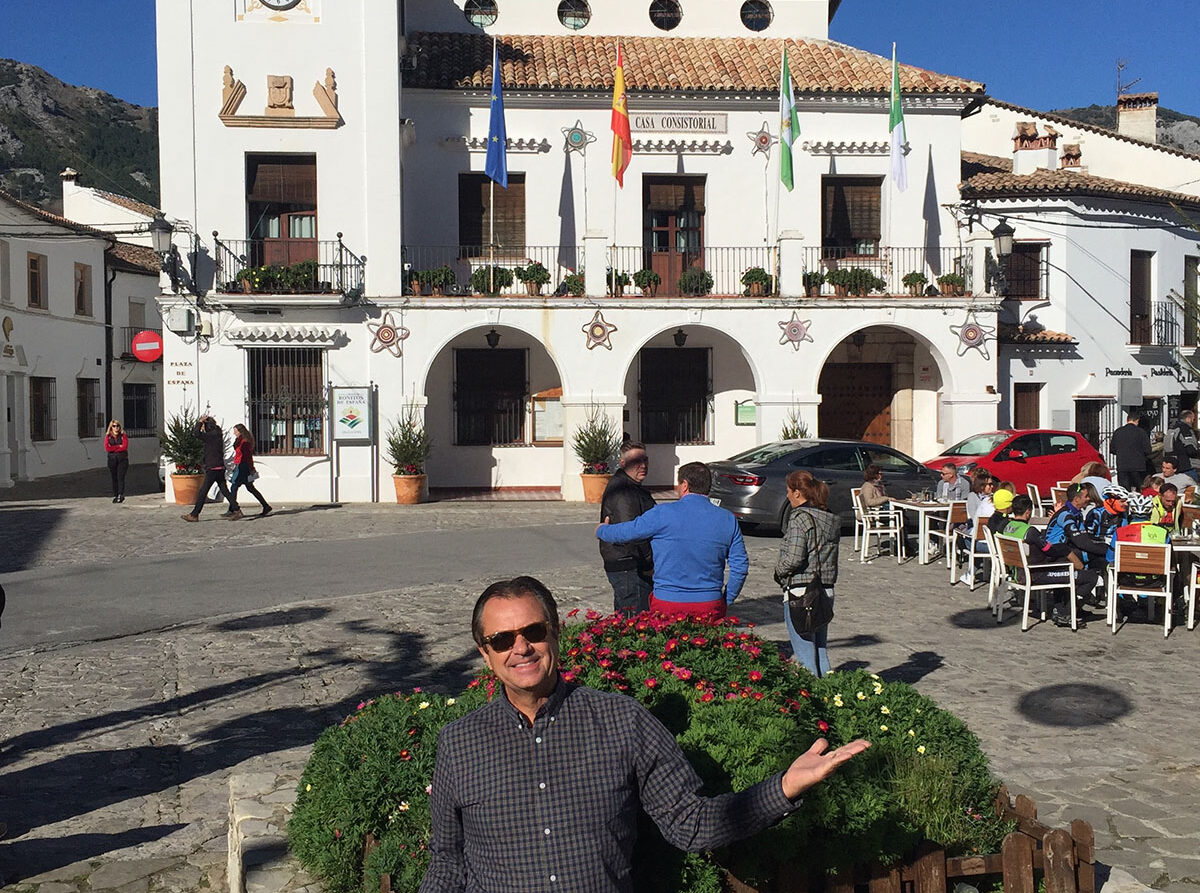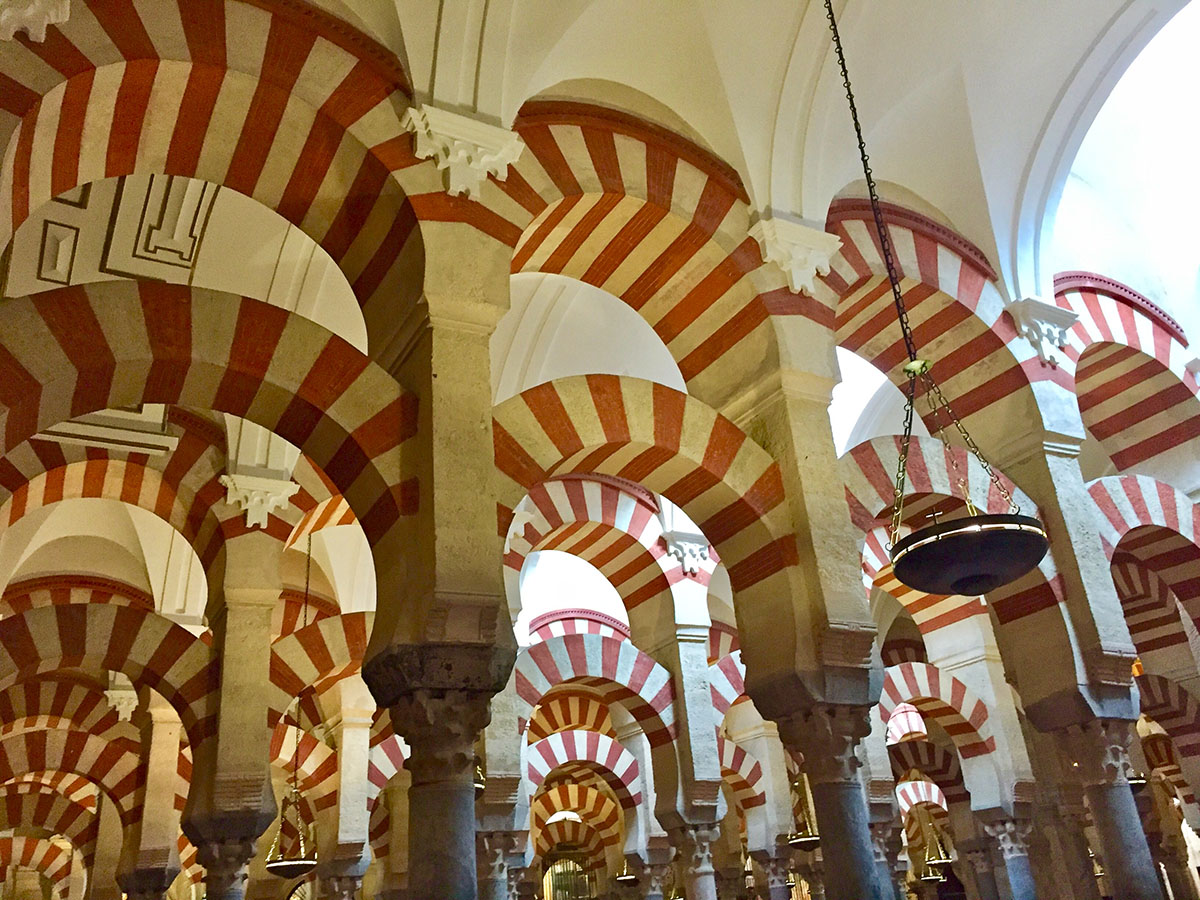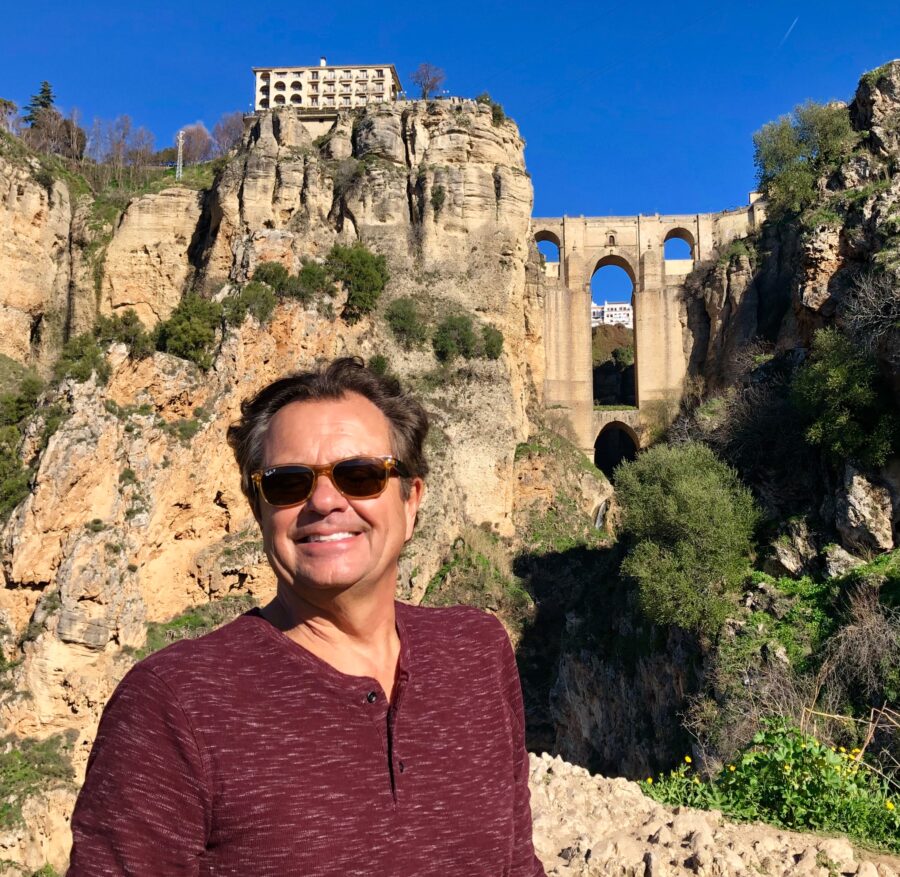The Puento Nuevo Bridge in Ronda is best viewed by hiking to the bottom of the El Tajo Canyon in the late afternoon
Alluring Andalucia
Visiting Malaga on a cruise, our family was only slightly impressed with this seaside city. But now that we have stayed here as we live seasonally, this town became one of our favorite finds. We explored Andalucia in January and found warm blue skies. In fact, this region reportedly gets 320 days of sun a year. But let me start from the beginning.
Arriving into Malaga, we drove up to Ronda, our home base for the Pueblo Blanca towns of Andalucia. We chose the outstanding La Perla Blanca on Fuente de La Higuera, 11. la-perlablanca.com. Nestled in their private vineyard, this rural retreat was just minutes from Ronda. We enjoyed the dining room with fireplace where we could pop in for a game of cards and a cappuccino. A basket filled with fresh croissants and local Serrano ham and cheeses was delivered to our door each morning where you could eat around the pool or in the courtyard.
Ronda is at the top of any Andalucian list, and we found the town charming too. Ronda is perched on a mountainous gash carved by the Guadalevin River. Ernest Hemingway noted, “The entire town is a romantic background”. The breathtaking views of the Puento Nuevo Bridge from the bottom of the El Tajo Canyon and from the Jardines De Cuenca down to the Puente Viejo stone bridge are spectacular. The best time to walk into the canyon is late afternoon so the sun is behind you – the brilliant blue sky against the arch stone bridge is phenomenal. View the bridge from the Jardine side in the morning to achieve the same effect.
Each visit into the town, we parked our car outside of the Carrefour and walked past La Casa del Jamon on Calle Jerez, 16 where we enjoyed several stops for cappuccinos. The butchers were amused at our interest as they deftly sliced the jamon into thin pieces.
Another discovery was Il Forno a Legna on Calle Nueva, 24. I know this is Italian, but their bruschetta was amazing and their pizza was so fresh, watching them pull the pizza from their giant stone oven.
The White Villages or Pueblos Blancos
We stayed in Ronda so we could visit these cool villages. Painted to keep buildings cool from the sun, the white lime walls of the houses are in colorful contrast to the deep blue of the skies.
Setenil de las Bodegas is built into the side of a cliff. From Setinil, make sure to drive 9120 into the town of Olvera because the fields of olive trees between the two villages is the best on our weeklong visit. We walked up the cobblestones to the small fortress for great views of the mountains and olive farms below. Then drive 374 and 384 back into Ronda for another gorgeous road trip.

Grazalema was another scenic Pueblo Blanco village
Grazalema was another mountain village with a winding forest drive through the Sierra de Grazalema Natural Park. We were fascinated by the mountain goats as we drove 9104, a scenic route to Zahara de la Sierra . This is a stunning drive, although a slow one due to the narrow road and cliffside dropoff. Zahara sits above a turquoise reservoir and has the Nasrid Castle at the top of the sheer cliff for a great uphill hike. The final scary drive was up to Juzcar. Sony asked if they could paint this town blue for their premiere of the movie, The Smurfs, and they said yes. So every home is blue. It is tiny and there is not much here, but if you love mountain drives and a different color village, this is a fun jaunt.
Leaving Ronda, we drove through Osuna and Ecija and this was definitely the scenic route into Cordoba, where we dropped the car after settling into Hotel Mezquita. This hotel was directly across from the famed and beautiful Mezquita. Although the hotel was actually quiet for easy sleeping, we felt the warmth and sociable factor was lacking.
The capital of Muslim Spain, Cordoba is a mix of historic treasures and tangled old streets which gave the town a special vibe that was a bit bohemian and artsy. The Roman Bridge and the Jewish Quarter were great strolls, and we were delighted by the Alcazar de los Reyes Christianos. This was the medieval residence of King Ferdinand and Queen Isabella before they moved into the Alhambra in Granada in 1492. The gardens and towers were picturesque.

The Mezquita of Cordoba with its elegant red and white giant arches of marble and granite
The Mezquita is a remarkable Moorish mosque built in the 8th century with red and white giant arches and 856 columns made of marble and granite. It is stunning with its limited light creating a cavernous effect. When Cordoba was rejoined into Christendom, a Renaissance cathedral was built directly in the middle inside of this monstrous piece of architecture. We were truly impressed.
One of our great finds was La Quarta Taberna, a cozy restaurant with such delicious food that we ate here twice. Everything we dined on was fabulous, including their decadent paella. Yum!
The fun of living in Spain is the ability to take day trips so we rode the train into Seville. From the train station, we took the #21 bus to the Plaza de Espana with its sweeping promenade, and then walked past pastel buildings to the Seville Cathedral, the largest Gothic cathedral in the world, where Christopher Columbus is buried. We followed advice from a post and took the elevator up to the Metropol Parasol for views of the city. It was quirky architecture with views, but not worthy of the 10 euros. The flamenco dancers performing on the street were more interesting!
We had been advised to ride the bus to Granada instead of the train, and Granada was another surprise, being populated since 5,500 B.C. Nestled in the valley of the snow capped Sierra Nevadas, the Moors ruled here for centuries and their influence is everywhere, from the winding cobblestone streets to the beautiful doors. We chose the Albayzin neighborhood, the old Muslim quarter, off of Carrera del Darro for our lodging. This riverside stone road has cobbled bridges and became one of our favorite evening walks. Rosa Comares B&B had a view balcony of the amazing Alhambra, but when we return we found the Hotel Palacio de Santa Ines in the Albayzin neighborhood to be the better choice.
Shopping in the Alcaiceria market felt like walking the bazaar of Istanbul. We followed the stone steps that wound up the hill to the Mirador de San Nicolas for the perfect evening sunset view of the Alhambra and the city. The tree lined street, Carrera de la Virgen, was another area to explore as we strolled the Genil River park walkways all the way up to the Sacramonte, the cave homes of the gypsies and bohemians for centuries.

The lavish Alhambra Palace of Granada
The crown jewel of Granada, though, is the Alhambra, sitting on Sabika Hill with sweeping views over the city. This lavish 13 century palace and fortress was a highlight of our time in Spain. We wandered through the Nasrid Palace, into the Alcazaba fortress, and the Generalife gardens, thoroughly enamored with this magnificent structure and the history of the area we were truly learning about. The tree lined streets outside of the Alhambra are perfect for an afternoon stroll and a glass of wine on the Hotel Alhambra Palace balcony. This was a great place to live seasonally. The shopping and cafes, the history and the flowering alleys became a haven, as well as, a home for us.
We took the advice again and rode the bus into Malaga, and walked all the way to our lovely La Casa Azul B&B, Avenida de Pries, 20. lacasaazulmalaga.com. Carolina, Carlos, and Esteban took excellent care of us from amazing breakfast buffets each morning to meticulous directions and assistance while we lived in their fabulous city. With a grocery store around the corner and one block from the beachfront walk, we felt totally at home. We wandered the Parque de Malaga daily, as well as the beach, even taking a blanket out to the seaside and reading and doing yoga. From the Roman Theater, the Castillo de Gibralfaro hike, and the Pompidou, we walked 25,000 steps a day and never tired. Picasso was from Malaga and you have to go to the Picasso Museum. Experiencing coffee at El Ultimo Mono and fish and chips at Papa y Pepe, we relaxed into a delightful rhythm in this favorite living seasonally location.
Surprises:
- The brilliant blue sky every day. 320 days a year
- The hills of olive groves. 4,500 square miles and over 40 million trees
- Every whitewashed village had orange trees lining each street and they were popping with fruit.
- Each Pueblo Blanca village bustled with locals spilling out into the streets, sitting at cafes and on park benches.
- How much we loved Southern Spain!


Recent Comments